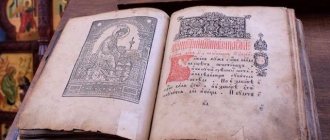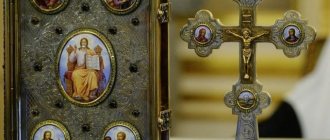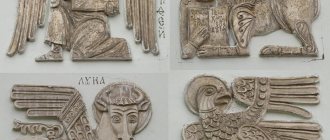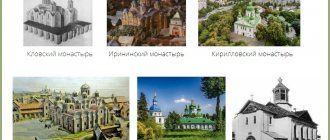When were the Gospels written?
As far as I know, the modern text of the Gospels was not recorded until the 4th century.
Where is the guarantee that these texts correspond to the early, authentic Gospels, since the latter, as I understand it, have not survived? And where is the guarantee that there WERE early texts at all; perhaps the Gospel was composed several centuries after the so-called crucifixion? SV., Moscow
It may be a little surprising for someone to learn that the texts of many of the ancient authors that we read and whose existence is beyond doubt have not reached us - there were no photocopiers then. For example, none of the works of Plato, Aristotle, or many other ancient philosophers have been preserved in the original. In the Middle Ages, Aristotle “came” to Europe through the Arabs, so the works were read in translation from Arabic (although early Latin translations were later found). All this in no way undermines the confidence of the scientific world either in the fact of the existence of Aristotle, or in the fact that the works we read were actually written by this Greek philosopher.
And although the earliest Gospel manuscripts date back to the 11th-111th centuries. this does not undermine confidence in the Gospel text from a purely scientific point of view, because Compared with any ancient author, with the works of ancient classics, the Gospels and all the books of the New Testament are in a very advantageous position. This applies to the number of manuscripts found (more than 5 thousand!), and to the shortness of time separating the oldest of them from the original, and to the seriousness and volume of critical work carried out on the text.
The Church believes that the Gospels were written in the 1st century AD, when the authors who wrote them lived: Matthew, Mark, Luke and John. But the Tradition preserved by the Church, until recently, was not directly confirmed by the finds of Gospel manuscripts dating back to the 1st century.
But even before that, there were testimonies from church writers of the 2nd-4th centuries, telling about the Evangelists and the circumstances of their writing of the Gospels. Most of this evidence was collected at the beginning of the 4th century by Eusebius of Caesarea in his famous “Ecclesiastical History”: these are the testimonies of Panius (c. 130), St. Irenaeus of Lyons (late 2nd century), Clement of Alexandria, Tertullian (late 2nd - early 1st centuries), Origen (1st half of 1Mb.), etc. It is significant that, in support of their words, church writers, as a rule, , refer to an older tradition that has reached them.
Another important confirmation that the Gospels were written already in the 1st century is the presence of Gospel quotations in the works of the late 1st - early 2nd centuries: in the First Epistle of St. Clement of Rome (90s of the 1st century), in the “Teaching of the Twelve Apostles” (late 1st-beginning of the 1st century), in the Epistles of St. Ignatius the God-Bearer (c. 107) and in other texts.
In addition, there is a whole series of evidence from opponents of Christianity, who cannot in any way be accused of hidden sympathy. These testimonies confirm the historicity of the personalities of Jesus Christ, John the Baptist and James the Lord's brother. To them
include Josephus Flavius, Tacitus, Suetonius, Pliny Secundus the Younger, Lucian, Celsus and others.
And, of course, the manuscripts of the New Testament with the Gospel texts serve as confirmation of Church Tradition. The oldest of them are written on papyrus and, unfortunately, only fragments of the text are conveyed to us, since papyrus is a short-lived material. They were found mostly in Egypt, where climatic conditions allowed them to be well preserved.
The oldest record of the Gospel until recently was the Ryland papyrus, dating back to 120-130 AD. It preserves a fragment of the 18th chapter of the Gospel of John, which conveys Christ’s conversation with Pilate during the trial. It was found in Lower Egypt, in an insignificant village, among the letters of the soldiers who garrisoned here. This find is only 20-30 years distant from the time the Gospel was written, supposed by church tradition (96-YOgg.) - a very short period of time, considering that during this time the Gospel text should have managed to get to Egypt from Asia Minor (Ephesus), where he wrote the Gospel of St. Apostle John the Theologian.
Another ancient text, the Bodmer II papyrus, dates back, according to recently updated data, to the first half of the 2nd century. It may have been created later than the Ryeland papyrus, but it contains in very good preservation the text of almost the entire Gospel of John, written on 108 pages.
These findings, especially the Ryland papyrus published in 1935, have led even atheistic critics to place the date of the writing of the Gospels as we now know them at the end of the first century.
And yet, the lack of direct confirmation of the Gospel text by finds dating back to the 1st century gives rise to some modern researchers to assert that the primary text of the Gospel could be very different from what we know from manuscripts of the 2nd-3rd centuries, and to build different, sometimes intricate hypotheses about ways of creation and history of the formation of the Gospel.
But just recently a message appeared (book by K.P. Tied, 1996) about the text of the Gospel of Matthew, dated 64-69 years of the 1st century. This manuscript was known before (papyrus No. 64, containing part of Chapter 26 of the Gospel of Matthew, is kept in Oxford), only before it was dated to about the year 200, and now the time of creation has been determined more precisely. This text is probably the earliest known manuscript of the Gospel.
This recent rediscovery is of great scientific importance. It can be compared to the discovery of the image of Jesus Christ on the Shroud of Turin. And just as then, at the end of the 19th century, when science seemed to undermine faith in the reality of Christ and His Resurrection, the Shroud of Turin, studied by scientific methods, testified to the contrary, so now the oldest manuscript of the Gospel again tells us about Christ and confirms the Church Tradition about creation of the Gospel.
Vyacheslav ARTAMONOV,
student of the Orthodox St. Tikhon's Theological Institute
Literature:
1. Eusebius Pamphilus. Church history. - M.: Publishing house. Spaso-Pre-arr. Valaam Monastery, 1993 -446 pp.
2. Cassian (Bezobrazov), Christ and the Christian generation. -3rd ed. - Paris - Moscow: YMCA -Press. Russian way, 1996.- pp. 156-158, $78; 283-285, 303-306, 310-313, 317-318, 324-325, 348-349.
3. Metzger, Bruce M. Textology of the New Testament. -'M., 1996
4. Carsten Peter Thiede. Jesus selon Matthieu La nouvelle datation du papyrus Magdalen d'Oxford et I origine des Evangiles. Examen et discussion des dernieres objections scientifiques. P.: Francois-Xavier de Guibert. 1996-(118 p.)









